Access Data with Cards
Cards present information about your network for monitoring and troubleshooting; each card describes a particular aspect of the network. Cards are collected onto a workbench where all data relevant to a task or set of tasks is visible. You can add and remove cards from a workbench, increase or decrease their sizes, change the time period of the data shown on a card, and make copies of cards to show different levels of data at the same time.
Card Sizes
Cards are available in multiple sizes, from small to full screen. The level of the content on a card varies with the size of the card, with the highest level of information on the smallest card to the most detailed information on the full-screen card.
Card Size Summary
| Card Size | Small | Medium | Large | Full Screen |
|---|---|---|---|---|
| Primary Purpose |
|
|
|
|
Small Cards
Small cards provide an overview of the performance or statistical value of a given aspect of your network. They typically include an icon to identify the aspect being monitored, summary performance or statistics in the form of a graph or counts, and an indication of any related events.

Medium Cards
Medium cards provide the key measurements for a given aspect of your network. They include the same content as the small cards with additional, relevant information, such as related events or components.

Large Cards
Large cards provide detailed information for monitoring specific components or functions of a given aspect of your network. This granular view can aid in isolating and resolving existing issues or preventing potential issues. These cards frequently display statistics or graphs that help visualize data.
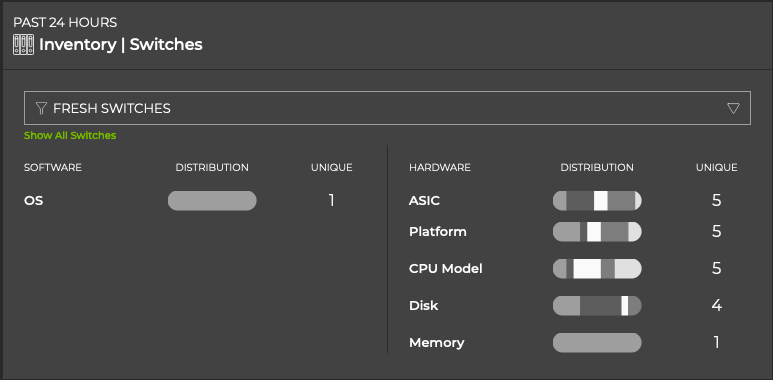
Full-Screen Cards
Full-screen cards show all available data about an aspect of your network. They typically display data in a tabular view that can be filtered and sorted. When relevant, they also display visualizations of that data.

Card Interactions
Each card focuses on a particular aspect of your network. They include:
- Validation summary: networkwide view of network health
- Events: information about all error and info events in the system
- What Just Happened: information about network issues and packet drops
- Device groups: information about the distribution of device components
- Inventory|Devices: information about all switches and hosts in the network
- Inventory|Switches: information about the components on a given switch
- Inventory|DPU: information about data processing units
- Inventory|Hosts: information about hosts
- Trace request: find available paths between two devices in the network fabric
There are five additional network services cards for session monitoring, including BGP, MLAG, EVPN, OSPF, and LLDP.
Add Cards to Your Workbench
Follow the steps in this section to add cards to your workbench. To add individual switch cards, refer to Add Switch Cards to Your Workbench.
To add one or more cards:
Click
in the header.
Locate the card you want to add to your workbench. Use the categories in the side navigation or Search to help narrow down your options.
Click on each card you want to add to your workbench.
When you have selected all of the cards you want to add to your workbench, you can confirm which cards have been selected by clicking the Cards Selected link. Modify your selection as needed.
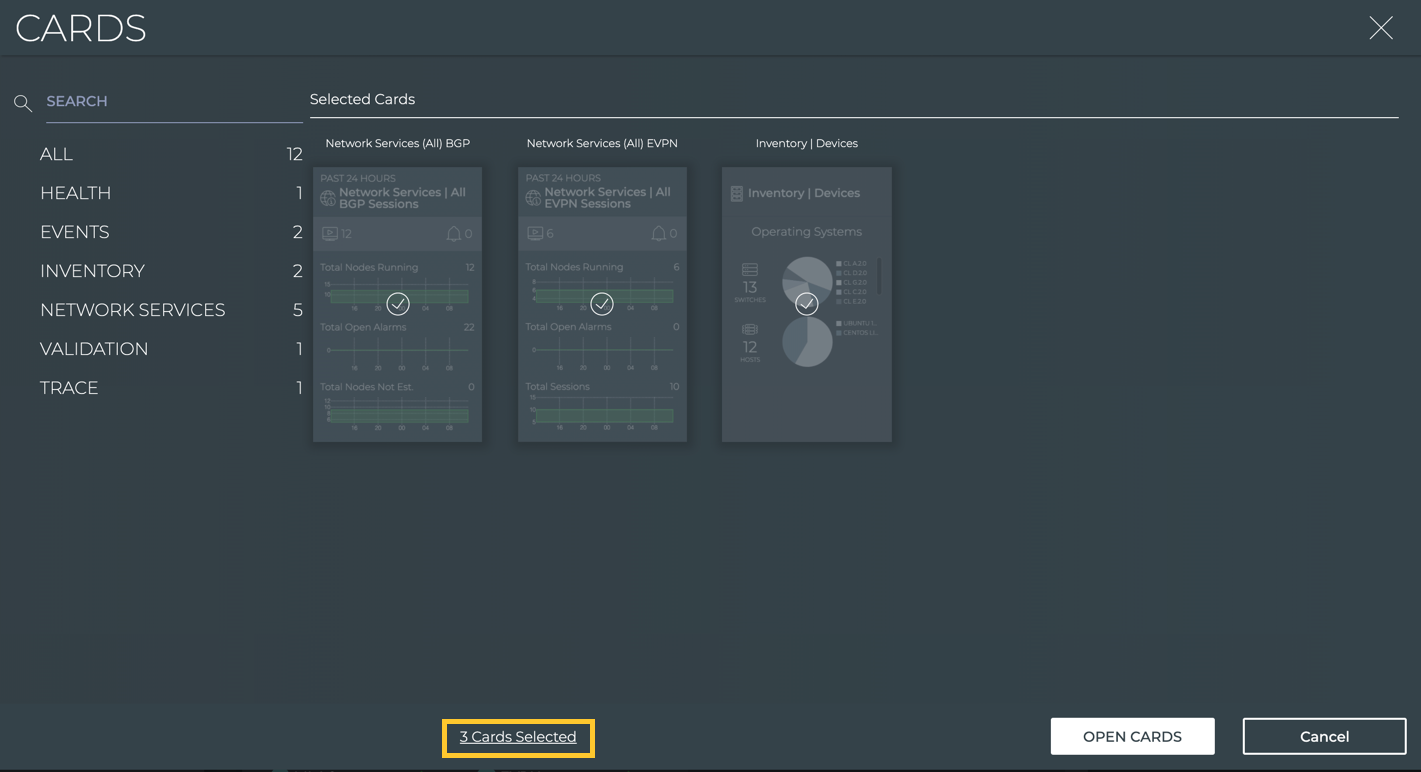
Click Open Cards to add the selected cards, or Cancel to return to your workbench without adding any cards.
The cards are placed at the end of the set of cards currently on the workbench. You might need to scroll down to see them. You can drag and drop the cards on the workbench to rearrange them.
Add Switch Cards to Your Workbench
You can add switch cards to a workbench through the Switches icon on the header or by searching for it through Global Search.
To add a switch card using the icon:
Click
, then select Open a device card.
Begin entering the hostname of the switch you want to monitor.
Select the device from the suggestions that appear.
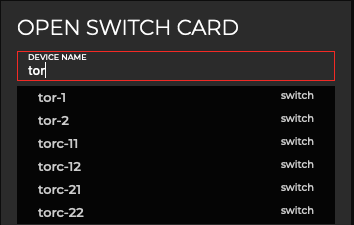
If you attempt to enter a hostname that is unknown to NetQ, a red border appears around the entry field and you are unable to select Add. Try checking for spelling errors. If you feel your entry is valid, but not an available choice, consult with your network administrator.
Click Add to add the switch card to your workbench, or Cancel to return to your workbench without adding the switch card.
To open the switch card by searching:
Click in Global Search.
Begin typing the name of a switch.

Select it from the options that appear.
Remove Cards from Your Workbench
To remove all the cards from your workbench, click the Clear icon in the header. To remove an individual card:
Hover over the card you want to remove.
Click
(More Actions menu).
Click Remove.
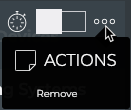
The card is removed from the workbench, but not from the application.
Change the Time Period for the Card Data
All cards have a default time period for the data shown on the card, typically the last 24 hours. You can change the time period to view the data during a different time range to aid analysis of previous or existing issues.
To change the time period for a card:
Hover over the card and select
in the header.
Select a time period from the dropdown list.
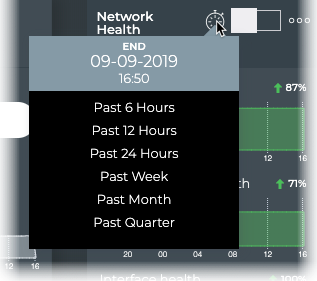
Changing the time period in this manner only changes the time period for the given card.
Change the Size of the Card
To change the card size:
Hover over the card.
Hover over the size picker and move the cursor to the right or left until the desired size option is highlighted.

One-quarter width opens a small card. One-half width opens a medium card. Three-quarters width opens a large card. Full width opens a full-screen card.
Click the picker. The card changes to the selected size, and might move its location on the workbench.
Table Settings
You can manipulate the tabular data displayed in a full-screen card by filtering and sorting the columns. To reposition the columns, drag and drop them using your mouse. You can also export the data presented in the table.
The following icons are common in the full-screen card view.
| Icon | Action | Description |
|---|---|---|
| Select All | Selects all items in the list. | |
| Clear All | Clears all existing selections in the list. | |
| Add Item | Adds item to the list. | |
| Edit | Edits the selected item. | |
| Delete | Removes the selected items. | |
| Filter | Filters the list using available parameters. | |
| Generate/Delete AuthKeys | Creates or removes NetQ CLI authorization keys. | |
| Open Cards | Opens the corresponding validation or trace card(s). | |
| Assign role | Opens role assignment options for switches. | |
| Export | Exports selected data into either a .csv or JSON-formatted file. |
When there are numerous items in a table, NetQ loads up to 25 by default and provides the rest in additional table pages. Pagination is displayed under the table.
